1 32 polytope
In 7-dimensional geometry, 132 is a uniform polytope, constructed from the E7 group.
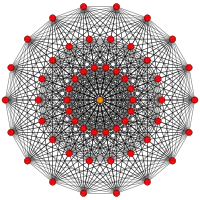 321 |
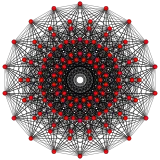 231 |
 132 | |||
 Rectified 321 |
 birectified 321 | ||||
 Rectified 231 |
 Rectified 132 | ||||
| Orthogonal projections in E7 Coxeter plane | |||||
|---|---|---|---|---|---|
Its Coxeter symbol is 132, describing its bifurcating Coxeter-Dynkin diagram, with a single ring on the end of one of the 1-node sequences.
The rectified 132 is constructed by points at the mid-edges of the 132.
These polytopes are part of a family of 127 (27-1) convex uniform polytopes in 7-dimensions, made of uniform polytope facets and vertex figures, defined by all permutations of rings in this Coxeter-Dynkin diagram: ![]()
![]()
![]()
![]()
![]()
![]()
![]()
![]()
![]()
![]()
![]() .
.
1_32 polytope
| 132 | |
|---|---|
| Type | Uniform 7-polytope |
| Family | 1k2 polytope |
| Schläfli symbol | {3,33,2} |
| Coxeter symbol | 132 |
| Coxeter diagram | |
| 6-faces | 182: 56 122 126 131 |
| 5-faces | 4284: 756 121 1512 121 2016 {34} |
| 4-faces | 23688: 4032 {33} 7560 111 12096 {33} |
| Cells | 50400: 20160 {32} 30240 {32} |
| Faces | 40320 {3} |
| Edges | 10080 |
| Vertices | 576 |
| Vertex figure | t2{35} |
| Petrie polygon | Octadecagon |
| Coxeter group | E7, [33,2,1], order 2903040 |
| Properties | convex |
This polytope can tessellate 7-dimensional space, with symbol 133, and Coxeter-Dynkin diagram, ![]()
![]()
![]()
![]()
![]()
![]()
![]()
![]()
![]()
![]()
![]()
![]()
![]() . It is the Voronoi cell of the dual E7* lattice.[1]
. It is the Voronoi cell of the dual E7* lattice.[1]
Alternate names
- Emanuel Lodewijk Elte named it V576 (for its 576 vertices) in his 1912 listing of semiregular polytopes.[2]
- Coxeter called it 132 for its bifurcating Coxeter-Dynkin diagram, with a single ring on the end of the 1-node branch.
- Pentacontihexa-hecatonicosihexa-exon (Acronym lin) - 56-126 facetted polyexon (Jonathan Bowers)[3]
Images
| E7 | E6 / F4 | B7 / A6 |
|---|---|---|
 [18] |
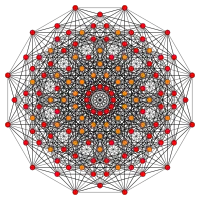 [12] |
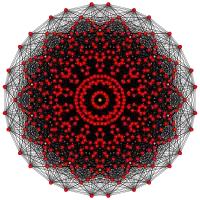 [7x2] |
| A5 | D7 / B6 | D6 / B5 |
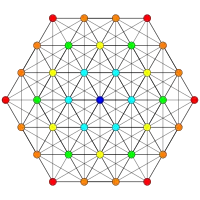 [6] |
 [12/2] |
 [10] |
| D5 / B4 / A4 | D4 / B3 / A2 / G2 | D3 / B2 / A3 |
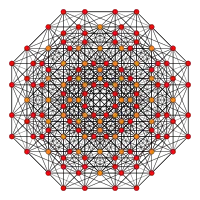 [8] |
 [6] |
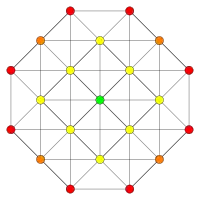 [4] |
Construction
It is created by a Wythoff construction upon a set of 7 hyperplane mirrors in 7-dimensional space.
The facet information can be extracted from its Coxeter-Dynkin diagram, ![]()
![]()
![]()
![]()
![]()
![]()
![]()
![]()
![]()
![]()
![]()
Removing the node on the end of the 2-length branch leaves the 6-demicube, 131, ![]()
![]()
![]()
![]()
![]()
![]()
![]()
![]()
![]()
Removing the node on the end of the 3-length branch leaves the 122, ![]()
![]()
![]()
![]()
![]()
![]()
![]()
![]()
![]()
The vertex figure is determined by removing the ringed node and ringing the neighboring node. This makes the birectified 6-simplex, 032, ![]()
![]()
![]()
![]()
![]()
![]()
![]()
![]()
![]()
![]()
![]()
Seen in a configuration matrix, the element counts can be derived by mirror removal and ratios of Coxeter group orders.[4]
| E7 | k-face | fk | f0 | f1 | f2 | f3 | f4 | f5 | f6 | k-figures | notes | |||||||
|---|---|---|---|---|---|---|---|---|---|---|---|---|---|---|---|---|---|---|
| A6 | ( ) | f0 | 576 | 35 | 210 | 140 | 210 | 35 | 105 | 105 | 21 | 42 | 21 | 7 | 7 | 2r{3,3,3,3,3} | E7/A6 = 72*8!/7! = 576 | |
| A3A2A1 | { } | f1 | 2 | 10080 | 12 | 12 | 18 | 4 | 12 | 12 | 6 | 12 | 3 | 4 | 3 | {3,3}x{3} | E7/A3A2A1 = 72*8!/4!/3!/2 = 10080 | |
| A2A2A1 | {3} | f2 | 3 | 3 | 40320 | 2 | 3 | 1 | 6 | 3 | 3 | 6 | 1 | 3 | 2 | { }∨{3} | E7/A2A2A1 = 72*8!/3!/3!/2 = 40320 | |
| A3A2 | {3,3} | f3 | 4 | 6 | 4 | 20160 | * | 1 | 3 | 0 | 3 | 3 | 0 | 3 | 1 | {3}∨( ) | E7/A3A2 = 72*8!/4!/3! = 20160 | |
| A3A1A1 | 4 | 6 | 4 | * | 30240 | 0 | 2 | 2 | 1 | 4 | 1 | 2 | 2 | Phyllic disphenoid | E7/A3A1A1 = 72*8!/4!/2/2 = 30240 | |||
| A4A2 | {3,3,3} | f4 | 5 | 10 | 10 | 5 | 0 | 4032 | * | * | 3 | 0 | 0 | 3 | 0 | {3} | E7/A4A2 = 72*8!/5!/3! = 4032 | |
| D4A1 | {3,3,4} | 8 | 24 | 32 | 8 | 8 | * | 7560 | * | 1 | 2 | 0 | 2 | 1 | { }∨( ) | E7/D4A1 = 72*8!/8/4!/2 = 7560 | ||
| A4A1 | {3,3,3} | 5 | 10 | 10 | 0 | 5 | * | * | 12096 | 0 | 2 | 1 | 1 | 2 | E7/A4A1 = 72*8!/5!/2 = 12096 | |||
| D5A1 | h{4,3,3,3} | f5 | 16 | 80 | 160 | 80 | 40 | 16 | 10 | 0 | 756 | * | * | 2 | 0 | { } | E7/D5A1 = 72*8!/16/5!/2 = 756 | |
| D5 | 16 | 80 | 160 | 40 | 80 | 0 | 10 | 16 | * | 1512 | * | 1 | 1 | E7/D5 = 72*8!/16/5! = 1512 | ||||
| A5A1 | {3,3,3,3,3} | 6 | 15 | 20 | 0 | 15 | 0 | 0 | 6 | * | * | 2016 | 0 | 2 | E7/A5A1 = 72*8!/6!/2 = 2016 | |||
| E6 | {3,32,2} | f6 | 72 | 720 | 2160 | 1080 | 1080 | 216 | 270 | 216 | 27 | 27 | 0 | 56 | * | ( ) | E7/E6 = 72*8!/72/6! = 56 | |
| D6 | h{4,3,3,3,3} | 32 | 240 | 640 | 160 | 480 | 0 | 60 | 192 | 0 | 12 | 32 | * | 126 | E7/D6 = 72*8!/32/6! = 126 | |||
Related polytopes and honeycombs
The 132 is third in a dimensional series of uniform polytopes and honeycombs, expressed by Coxeter as 13k series. The next figure is the Euclidean honeycomb 133 and the final is a noncompact hyperbolic honeycomb, 134.
| Space | Finite | Euclidean | Hyperbolic | |||
|---|---|---|---|---|---|---|
| n | 4 | 5 | 6 | 7 | 8 | 9 |
| Coxeter group |
A3A1 | A5 | D6 | E7 | =E7+ | =E7++ |
| Coxeter diagram |
||||||
| Symmetry | [3−1,3,1] | [30,3,1] | [31,3,1] | [32,3,1] | [[33,3,1]] | [34,3,1] |
| Order | 48 | 720 | 23,040 | 2,903,040 | ∞ | |
| Graph |  |
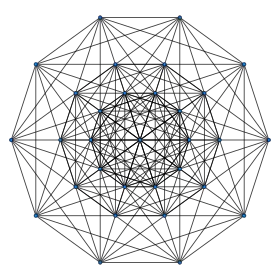 |
 |
- | - | |
| Name | 13,-1 | 130 | 131 | 132 | 133 | 134 |
| 1k2 figures in n dimensions | |||||||||||
|---|---|---|---|---|---|---|---|---|---|---|---|
| Space | Finite | Euclidean | Hyperbolic | ||||||||
| n | 3 | 4 | 5 | 6 | 7 | 8 | 9 | 10 | |||
| Coxeter group |
E3=A2A1 | E4=A4 | E5=D5 | E6 | E7 | E8 | E9 = = E8+ | E10 = = E8++ | |||
| Coxeter diagram |
|||||||||||
| Symmetry (order) |
[3−1,2,1] | [30,2,1] | [31,2,1] | [[32,2,1]] | [33,2,1] | [34,2,1] | [35,2,1] | [36,2,1] | |||
| Order | 12 | 120 | 1,920 | 103,680 | 2,903,040 | 696,729,600 | ∞ | ||||
| Graph |  |
 |
 |
 |
 |
 |
- | - | |||
| Name | 1−1,2 | 102 | 112 | 122 | 132 | 142 | 152 | 162 | |||
Rectified 1_32 polytope
| Rectified 132 | |
|---|---|
| Type | Uniform 7-polytope |
| Schläfli symbol | t1{3,33,2} |
| Coxeter symbol | 0321 |
| Coxeter-Dynkin diagram | |
| 6-faces | 758 |
| 5-faces | 12348 |
| 4-faces | 72072 |
| Cells | 191520 |
| Faces | 241920 |
| Edges | 120960 |
| Vertices | 10080 |
| Vertex figure | {3,3}×{3}×{} |
| Coxeter group | E7, [33,2,1], order 2903040 |
| Properties | convex |
The rectified 132 (also called 0321) is a rectification of the 132 polytope, creating new vertices on the center of edge of the 132. Its vertex figure is a duoprism prism, the product of a regular tetrahedra and triangle, doubled into a prism: {3,3}×{3}×{}.
Alternate names
- Rectified pentacontihexa-hecatonicosihexa-exon for rectified 56-126 facetted polyexon (acronym rolin) (Jonathan Bowers)[5]
Construction
It is created by a Wythoff construction upon a set of 7 hyperplane mirrors in 7-dimensional space. These mirrors are represented by its Coxeter-Dynkin diagram, ![]()
![]()
![]()
![]()
![]()
![]()
![]()
![]()
![]()
![]()
![]() , and the ring represents the position of the active mirror(s).
, and the ring represents the position of the active mirror(s).
Removing the node on the end of the 3-length branch leaves the rectified 122 polytope, ![]()
![]()
![]()
![]()
![]()
![]()
![]()
![]()
![]()
Removing the node on the end of the 2-length branch leaves the demihexeract, 131, ![]()
![]()
![]()
![]()
![]()
![]()
![]()
![]()
![]()
Removing the node on the end of the 1-length branch leaves the birectified 6-simplex, ![]()
![]()
![]()
![]()
![]()
![]()
![]()
![]()
![]()
![]()
![]()
The vertex figure is determined by removing the ringed node and ringing the neighboring node. This makes the tetrahedron-triangle duoprism prism, {3,3}×{3}×{}, ![]()
![]()
![]()
![]()
![]()
![]()
![]()
![]()
![]()
![]()
![]()
Seen in a configuration matrix, the element counts can be derived by mirror removal and ratios of Coxeter group orders.[6]
| E7 | k-face | fk | f0 | f1 | f2 | f3 | f4 | f5 | f6 | k-figures | notes | ||||||||||||||||||
|---|---|---|---|---|---|---|---|---|---|---|---|---|---|---|---|---|---|---|---|---|---|---|---|---|---|---|---|---|---|
| A3A2A1 | ( ) | f0 | 10080 | 24 | 24 | 12 | 36 | 8 | 12 | 36 | 18 | 24 | 4 | 12 | 18 | 24 | 12 | 6 | 6 | 8 | 12 | 6 | 3 | 4 | 2 | 3 | {3,3}x{3}x{ } | E7/A3A2A1 = 72*8!/4!/3!/2 = 10080 | |
| A2A1A1 | { } | f1 | 2 | 120960 | 2 | 1 | 3 | 1 | 2 | 6 | 3 | 3 | 1 | 3 | 6 | 6 | 3 | 1 | 3 | 3 | 6 | 2 | 1 | 3 | 1 | 2 | ( )v{3}v{ } | E7/A2A1A1 = 72*8!/3!/2/2 = 120960 | |
| A2A2 | 01 | f2 | 3 | 3 | 80640 | * | * | 1 | 1 | 3 | 0 | 0 | 1 | 3 | 3 | 3 | 0 | 0 | 3 | 3 | 3 | 1 | 0 | 3 | 1 | 1 | {3}v( )v( ) | E7/A2A2 = 72*8!/3!/3! = 80640 | |
| A2A2A1 | 3 | 3 | * | 40320 | * | 0 | 2 | 0 | 3 | 0 | 1 | 0 | 6 | 0 | 3 | 0 | 3 | 0 | 6 | 0 | 1 | 3 | 0 | 2 | {3}v{ } | E7/A2A2A1 = 72*8!/3!/3!/2 = 40320 | |||
| A2A1A1 | 3 | 3 | * | * | 120960 | 0 | 0 | 2 | 1 | 2 | 0 | 1 | 2 | 4 | 2 | 1 | 1 | 2 | 4 | 2 | 1 | 2 | 1 | 2 | { }v{ }v( ) | E7/A2A1A1 = 72*8!/3!/2/2 = 120960 | |||
| A3A2 | 02 | f3 | 4 | 6 | 4 | 0 | 0 | 20160 | * | * | * | * | 1 | 3 | 0 | 0 | 0 | 0 | 3 | 3 | 0 | 0 | 0 | 3 | 1 | 0 | {3}v( ) | E7/A3A2 = 72*8!/4!/3! = 20160 | |
| 011 | 6 | 12 | 4 | 4 | 0 | * | 20160 | * | * | * | 1 | 0 | 3 | 0 | 0 | 0 | 3 | 0 | 3 | 0 | 0 | 3 | 0 | 1 | |||||
| A3A1 | 6 | 12 | 4 | 0 | 4 | * | * | 60480 | * | * | 0 | 1 | 1 | 2 | 0 | 0 | 1 | 2 | 2 | 1 | 0 | 2 | 1 | 1 | Sphenoid | E7/A3A1 = 72*8!/4!/2 = 60480 | |||
| A3A1A1 | 6 | 12 | 0 | 4 | 4 | * | * | * | 30240 | * | 0 | 0 | 2 | 0 | 2 | 0 | 1 | 0 | 4 | 0 | 1 | 2 | 0 | 2 | { }v{ } | E7/A3A1A1 = 72*8!/4!/2/2 = 30240 | |||
| A3A1 | 02 | 4 | 6 | 0 | 0 | 4 | * | * | * | * | 60480 | 0 | 0 | 0 | 2 | 1 | 1 | 0 | 1 | 2 | 2 | 1 | 1 | 1 | 2 | Sphenoid | E7/A3A1 = 72*8!/4!/2 = 60480 | ||
| A4A2 | 021 | f4 | 10 | 30 | 20 | 10 | 0 | 5 | 5 | 0 | 0 | 0 | 4032 | * | * | * | * | * | 3 | 0 | 0 | 0 | 0 | 3 | 0 | 0 | {3} | E7/A4A2 = 72*8!/5!/3! = 4032 | |
| A4A1 | 10 | 30 | 20 | 0 | 10 | 5 | 0 | 5 | 0 | 0 | * | 12096 | * | * | * | * | 1 | 2 | 0 | 0 | 0 | 2 | 1 | 0 | { }v() | E7/A4A1 = 72*8!/5!/2 = 12096 | |||
| D4A1 | 0111 | 24 | 96 | 32 | 32 | 32 | 0 | 8 | 8 | 8 | 0 | * | * | 7560 | * | * | * | 1 | 0 | 2 | 0 | 0 | 2 | 0 | 1 | E7/D4A1 = 72*8!/8/4!/2 = 7560 | |||
| A4 | 021 | 10 | 30 | 10 | 0 | 20 | 0 | 0 | 5 | 0 | 5 | * | * | * | 24192 | * | * | 0 | 1 | 1 | 1 | 0 | 1 | 1 | 1 | ( )v( )v( ) | E7/A4 = 72*8!/5! = 34192 | ||
| A4A1 | 10 | 30 | 0 | 10 | 20 | 0 | 0 | 0 | 5 | 5 | * | * | * | * | 12096 | * | 0 | 0 | 2 | 0 | 1 | 1 | 0 | 2 | { }v() | E7/A4A1 = 72*8!/5!/2 = 12096 | |||
| 03 | 5 | 10 | 0 | 0 | 10 | 0 | 0 | 0 | 0 | 5 | * | * | * | * | * | 12096 | 0 | 0 | 0 | 2 | 1 | 0 | 1 | 2 | |||||
| D5A1 | 0211 | f5 | 80 | 480 | 320 | 160 | 160 | 80 | 80 | 80 | 40 | 0 | 16 | 16 | 10 | 0 | 0 | 0 | 756 | * | * | * | * | 2 | 0 | 0 | { } | E7/D5A1 = 72*8!/16/5!/2 = 756 | |
| A5 | 022 | 20 | 90 | 60 | 0 | 60 | 15 | 0 | 30 | 0 | 15 | 0 | 6 | 0 | 6 | 0 | 0 | * | 4032 | * | * | * | 1 | 1 | 0 | E7/A5 = 72*8!/6! = 4032 | |||
| D5 | 0211 | 80 | 480 | 160 | 160 | 320 | 0 | 40 | 80 | 80 | 80 | 0 | 0 | 10 | 16 | 16 | 0 | * | * | 1512 | * | * | 1 | 0 | 1 | E7/D5 = 72*8!/16/5! = 1512 | |||
| A5 | 031 | 15 | 60 | 20 | 0 | 60 | 0 | 0 | 15 | 0 | 30 | 0 | 0 | 0 | 6 | 0 | 6 | * | * | * | 4032 | * | 0 | 1 | 1 | E7/A5 = 72*8!/6! = 4032 | |||
| A5A1 | 15 | 60 | 0 | 20 | 60 | 0 | 0 | 0 | 15 | 30 | 0 | 0 | 0 | 0 | 6 | 6 | * | * | * | * | 2016 | 0 | 0 | 2 | E7/A5A1 = 72*8!/6!/2 = 2016 | ||||
| E6 | 0221 | f6 | 720 | 6480 | 4320 | 2160 | 4320 | 1080 | 1080 | 2160 | 1080 | 1080 | 216 | 432 | 270 | 432 | 216 | 0 | 27 | 72 | 27 | 0 | 0 | 56 | * | * | ( ) | E7/E6 = 72*8!/72/6! = 56 | |
| A6 | 032 | 35 | 210 | 140 | 0 | 210 | 35 | 0 | 105 | 0 | 105 | 0 | 21 | 0 | 42 | 0 | 21 | 0 | 7 | 0 | 7 | 0 | * | 576 | * | E7/A6 = 72*8!/7! = 576 | |||
| D6 | 0311 | 240 | 1920 | 640 | 640 | 1920 | 0 | 160 | 480 | 480 | 960 | 0 | 0 | 60 | 192 | 192 | 192 | 0 | 0 | 12 | 32 | 32 | * | * | 126 | E7/D6 = 72*8!/32/6! = 126 | |||
Images
| E7 | E6 / F4 | B7 / A6 |
|---|---|---|
 [18] |
 [12] |
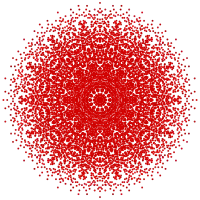 [14] |
| A5 | D7 / B6 | D6 / B5 |
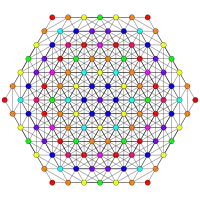 [6] |
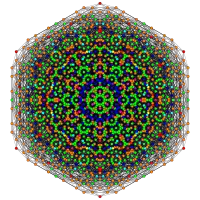 [12/2] |
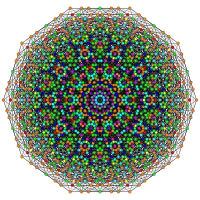 [10] |
| D5 / B4 / A4 | D4 / B3 / A2 / G2 | D3 / B2 / A3 |
 [8] |
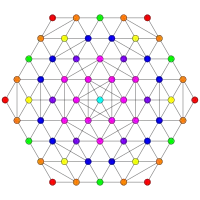 [6] |
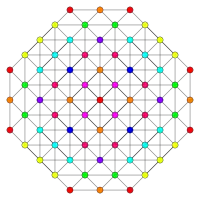 [4] |
See also
Notes
- The Voronoi Cells of the E6* and E7* Lattices Archived 2016-01-30 at the Wayback Machine, Edward Pervin
- Elte, 1912
- Klitzing, (o3o3o3x *c3o3o3o - lin)
- Coxeter, Regular Polytopes, 11.8 Gossett figures in six, seven, and eight dimensions, p. 202-203
- Klitzing, (o3o3x3o *c3o3o3o - rolin)
- Coxeter, Regular Polytopes, 11.8 Gossett figures in six, seven, and eight dimensions, p. 202-203
References
- Elte, E. L. (1912), The Semiregular Polytopes of the Hyperspaces, Groningen: University of Groningen
- H. S. M. Coxeter, Regular Polytopes, 3rd Edition, Dover New York, 1973
- Kaleidoscopes: Selected Writings of H.S.M. Coxeter, edited by F. Arthur Sherk, Peter McMullen, Anthony C. Thompson, Asia Ivic Weiss, Wiley-Interscience Publication, 1995, ISBN 978-0-471-01003-6
- (Paper 24) H.S.M. Coxeter, Regular and Semi-Regular Polytopes III, [Math. Zeit. 200 (1988) 3-45]
- Klitzing, Richard. "7D uniform polytopes (polyexa)". o3o3o3x *c3o3o3o - lin, o3o3x3o *c3o3o3o - rolin